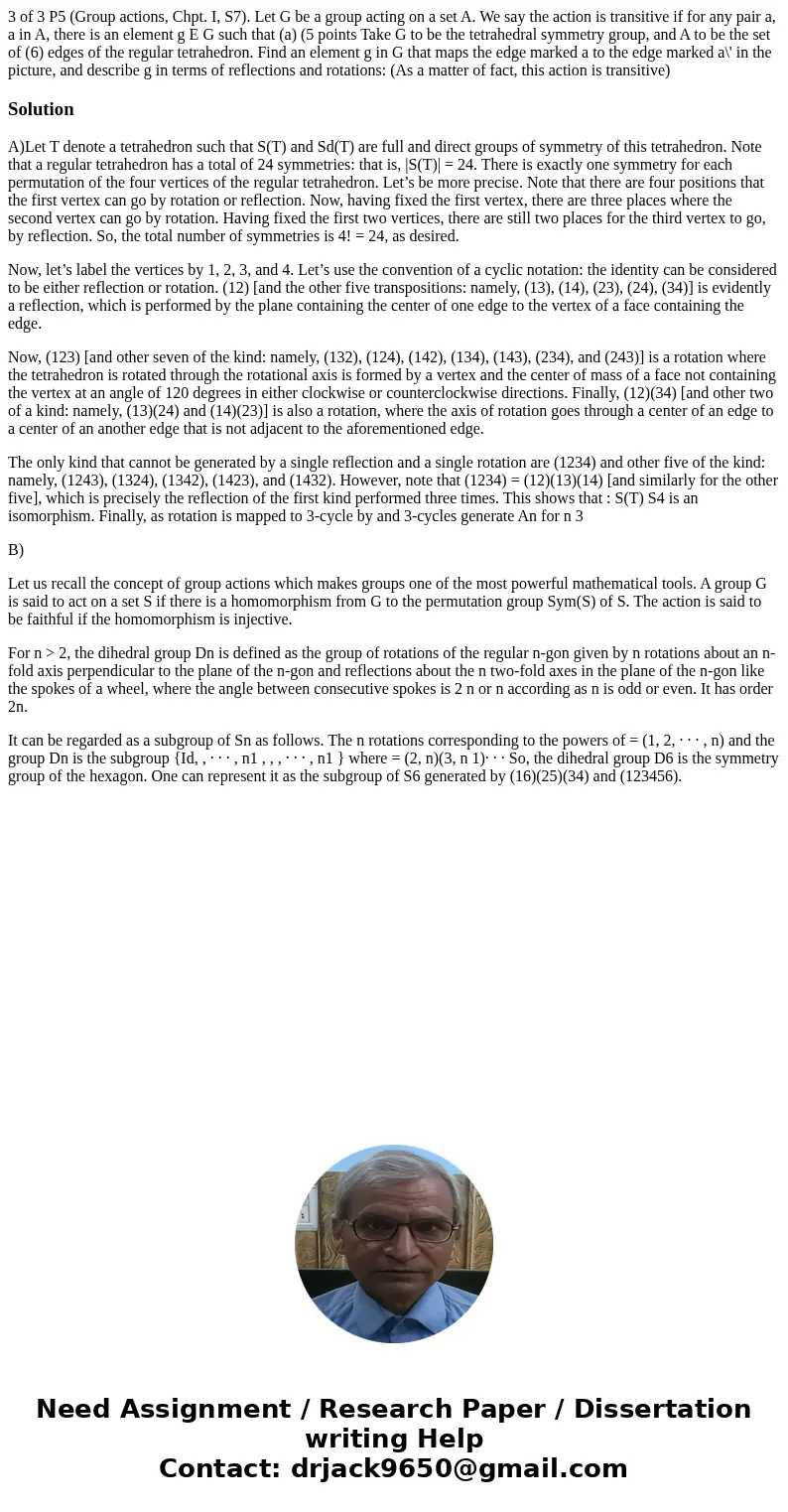3 of 3 P5 Group actions Chpt I S7 Let G be a group acting on
Solution
A)Let T denote a tetrahedron such that S(T) and Sd(T) are full and direct groups of symmetry of this tetrahedron. Note that a regular tetrahedron has a total of 24 symmetries: that is, |S(T)| = 24. There is exactly one symmetry for each permutation of the four vertices of the regular tetrahedron. Let’s be more precise. Note that there are four positions that the first vertex can go by rotation or reflection. Now, having fixed the first vertex, there are three places where the second vertex can go by rotation. Having fixed the first two vertices, there are still two places for the third vertex to go, by reflection. So, the total number of symmetries is 4! = 24, as desired.
Now, let’s label the vertices by 1, 2, 3, and 4. Let’s use the convention of a cyclic notation: the identity can be considered to be either reflection or rotation. (12) [and the other five transpositions: namely, (13), (14), (23), (24), (34)] is evidently a reflection, which is performed by the plane containing the center of one edge to the vertex of a face containing the edge.
Now, (123) [and other seven of the kind: namely, (132), (124), (142), (134), (143), (234), and (243)] is a rotation where the tetrahedron is rotated through the rotational axis is formed by a vertex and the center of mass of a face not containing the vertex at an angle of 120 degrees in either clockwise or counterclockwise directions. Finally, (12)(34) [and other two of a kind: namely, (13)(24) and (14)(23)] is also a rotation, where the axis of rotation goes through a center of an edge to a center of an another edge that is not adjacent to the aforementioned edge.
The only kind that cannot be generated by a single reflection and a single rotation are (1234) and other five of the kind: namely, (1243), (1324), (1342), (1423), and (1432). However, note that (1234) = (12)(13)(14) [and similarly for the other five], which is precisely the reflection of the first kind performed three times. This shows that : S(T) S4 is an isomorphism. Finally, as rotation is mapped to 3-cycle by and 3-cycles generate An for n 3
B)
Let us recall the concept of group actions which makes groups one of the most powerful mathematical tools. A group G is said to act on a set S if there is a homomorphism from G to the permutation group Sym(S) of S. The action is said to be faithful if the homomorphism is injective.
For n > 2, the dihedral group Dn is defined as the group of rotations of the regular n-gon given by n rotations about an n-fold axis perpendicular to the plane of the n-gon and reflections about the n two-fold axes in the plane of the n-gon like the spokes of a wheel, where the angle between consecutive spokes is 2 n or n according as n is odd or even. It has order 2n.
It can be regarded as a subgroup of Sn as follows. The n rotations corresponding to the powers of = (1, 2, · · · , n) and the group Dn is the subgroup {Id, , · · · , n1 , , , · · · , n1 } where = (2, n)(3, n 1)· · · So, the dihedral group D6 is the symmetry group of the hexagon. One can represent it as the subgroup of S6 generated by (16)(25)(34) and (123456).

 Homework Sourse
Homework Sourse